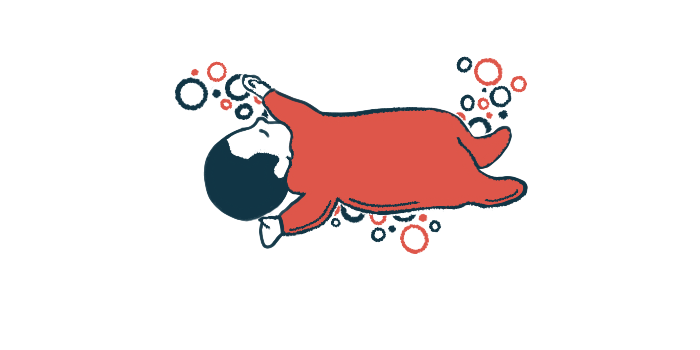Zolgensma may improve infants’ nighttime breathing
The gene therapy for SMA reduced sleep disordered breathing, study found
Written by |

Breathing disruptions during sleep, which were prevalent in infants with spinal muscular atrophy (SMA), tended to improve on Zolgensma (onasemnogene abeparvovec) treatment without the need for additional interventions, according to a recent study.
The only children who required treatment for sleep disordered breathing were those who had existing symptoms of muscle weakness when starting Zolgensma, or those who had clinical symptoms associated with their respiratory problems during sleep.
The clinical significance of sleep disordered breathing for asymptomatic children remains unclear. “The long-term trajectory and clinical significance of these findings remains to be determined in this emerging clinical population,” the researchers wrote.
The study, “Sleep disordered breathing in infants identified through newborn screening with spinal muscular atrophy,” was published in Sleep Medicine.
Weakness in the muscles needed for breathing leads to respiratory difficulties for many SMA patients. These breathing problems often are worse at night, when lying down, leading to sleep issues and contributing to chronic respiratory declines.
Disease-modifying therapies for SMA, including Zolgensma, have altered the SMA trajectory and improved the prognosis for many patients. Still, the effects of Zolgensma on sleep disordered breathing haven’t been established.
Initiating Zolgensma gene therapy
To learn more, the scientists conducted a retrospective review of sleep disordered breathing among infants with SMA in Canada who were identified via newborn screening and initiated on Zolgensma.
The analysis involved 11 children — seven boys and four girls — who were started on Zolgensma at a median age of 3.6 weeks. Five of these children had received Spinraza (nusinersen) while waiting for Zolgensma.
Among the infants, two were symptomatic with signs of muscle weakness when starting on Zolgensma; the remaining children were asymptomatic.
For participants with recorded scores on the Alberta Infant Motor Scale (AIMS), a test of motor function, the median score at the first test was in the 18th percentile, reflecting motor function below average for their age.
That finding suggests “there may be subtle motor weaknesses in our otherwise presymptomatic cohort,” the researchers noted.
Polysomnography (sleep study) for each infant
Polysomnography (PSG) was conducted for each infant at the time of their diagnosis and regularly thereafter for up to two years. Also known as a sleep study, this approach monitors a patient’s brain activity, oxygen levels, heart rate, and breathing during sleep.
All infants met the criteria for sleep disordered breathing during their first PSG. The most prevalent type of problem observed was central sleep apnea, or apnea that occurs when the brain doesn’t transmit appropriate signals to the breathing muscles.
This issue was seen in all 11 infants, but eased over time after Zolgensma gene therapy.
Among four participants with severe obstructive sleep apnea, two saw sustained improvements on treatment. This type of apnea is caused by blocked airways when the throat muscles relax during sleep.
No correlations were observed between AIMS motor scores and PSG sleep disordered breathing parameters, which were collected a median of 4.5 weeks apart.
Altogether, “after the administration of [Zolgensma], children have reduced sleep disordered breathing at one year of life compared to natural history cohorts [groups] of children with SMA type 1 without disease-modifying therapies,” the researchers wrote.
Most of the infants were managed with close monitoring, and respiratory parameters tended to improve on treatment over time.
Four children were recommended for treatment. These children were either symptomatic for muscle weakness when starting Zolgensma, or had overt clinical symptoms associated with their sleep disordered breathing.
Among two children who were symptomatic with muscle weakness when starting Zolgensma gene therapy, both were started on nighttime noninvasive ventilation and mechanical cough assistance to clear airway secretions.
One infant was treated with oral caffeine, which can help improve airway function, and with supplemental oxygen that was weaned off at 4 months old. The other child was recommended for tonsil removal. The parents declined, but the child did not improve by age 2 and was scheduled for surgery.
Overall, the findings demonstrate that while sleep disordered breathing is common in infants with SMA, “clinically significant sleep disordered breathing necessitating treatment was uncommon,” the researchers wrote.
More studies needed
Still, more work will be needed to understand the clinical significance of these findings in the long-term, the team noted.
“The longitudinal comparison of PSG parameters in healthy typically developing children and children with SMA treated with [Zolgensma] may further elucidate the significance of these PSG findings,” they wrote.
Moreover, “future studies that follow participants over a longer time period will be important to elucidate long-term respiratory outcomes.”







